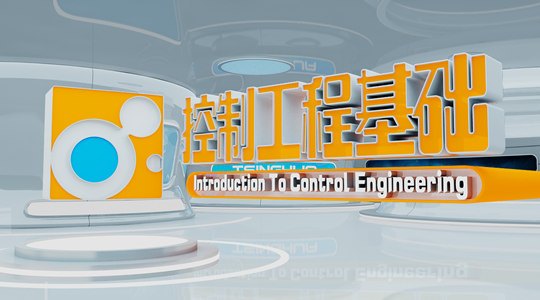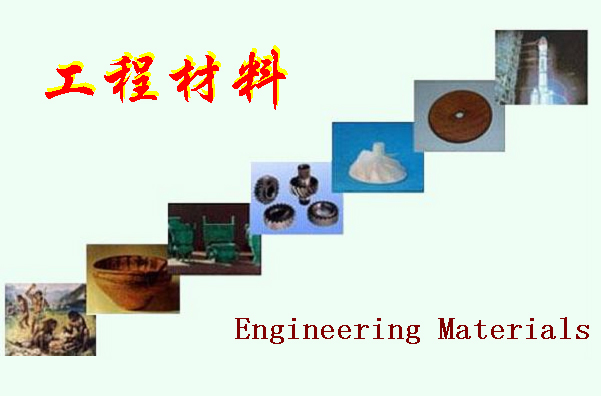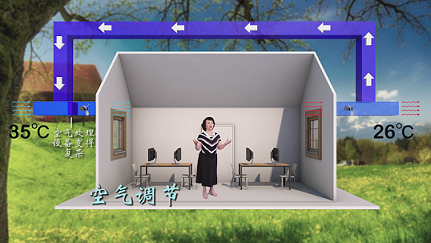
当前课程知识点:3ds Max: A Quick Start from Zero to One > Chapter 5: Basic Skills of Animation > 5.2.1 3ds Max Animation > 5.2.1
返回《3ds Max: A Quick Start from Zero to One》慕课在线视频课程列表
返回《3ds Max: A Quick Start from Zero to One》慕课在线视频列表
3dsMax的动画模块
大家好
上一讲
我们介绍了动画的由来
相信
你对帧有了一个基本的概念
那么
在3ds Max中
这个概念该如何体现呢
下面我们就来认识一下
动画制作模块
让你掌握帧的编辑技巧
一
动画模块介绍
3ds Max中
基本的动画制作模块
主要由动画控件
时间滑块
轨迹栏
及曲线编辑器构成
时间滑块和轨迹栏
时间滑块与轨迹栏
是一个小组
需要结合使用
时间滑块
用于定位当前帧的位置
播放和查看帧
轨迹栏
则用于选择和记录关键帧
轨迹栏里面的一格
就代表了一帧
大部分关键帧的调节和设置
都在这里完成
当点击设置关键点后
会形成一个方形帧
我们称为关键帧
默认的活动时间为0-100帧
或许你会想
如何查看
关键帧动画的效果呢
这主要由动画控件来负责
动画控件用于播放
调节
过滤和查看
关键帧动画效果
例如
你可以像用DVD一样
播放或暂停动画
或为模型打上一个关键帧
制作动画效果
甚至可以通过时间配置
设置帧速率
时间显示方式
轨迹栏的时间长度等
曲线编辑器
主要通过曲线控制动画速率
生成控制器动画
循环动画等效果
此外
曲线编辑器
还有动画制作的摄影表
这一块
我们用到的时候再做介绍吧
二
帧速率的设置
不同国家的帧速率
有不同要求
因此
我们第一次制作动画时
要进行设置
通常
电影动画
以每秒24帧进行播放
美国
日本电视格式标准采用的是
NTSC 制
以每秒 30 帧播放
而我国电视格式采用PAL制
以每秒25 帧播放
一般
我们会将“帧速率”
统一设置为每秒25帧
这样不但能与播放设备统一
后期软件衔接起来
也比较方便
第一步
在动画控件上的时间配置中
打开时间配置
第二步
将帧速率设置为PAL
这样
动画制作和播放时
就会以每秒25 帧进行计算了
好了
帧速率我们设置好了
现在我来考考你
100帧的动画
一共播放多少秒呢
一共放了4秒
因为它在
每秒25帧的情况下进行播放
一共读取了100帧
100除以25
就是4秒
你答对了吗
理解了关键帧
中间帧和帧速率的概念后
调节动画也就不难了
三
帧的编辑方法
动画制作
那么如何制作动画呢
首先打开自动关键帧
在第0帧
设置好模型的起步位置
将时间滑块滑到30帧处
在视图中移动模型
到结束位置
系统会自动将该位置
记录为关键帧
好了
开始播放动画吧
此时
程序会自动生成
起步到结束位置之间的动画
就实现了位移的动画效果
怎么样
是不是很酷呢
对了
完成后不要忘记关闭
自动关键帧
否则你后续的所有操作
就会被记录下来
动画是由
3ds Max自动生成的
我们只需调节画面运动的
关键状态就可以了
例如
一个小球
从左侧运动到右侧
它的整个运动状态
是由电脑自动生成的
我们只需要调
初始画面和结束画面
就可以了
接下来
让我们看看如何移动
复制和删除关键帧
移动
复制
和删除关键帧
首先
移动帧只需要选择帧
当它呈现为白色时
配合鼠标左键就可以移动了
复制也很简单
点击你要复制的帧
按住Shift拖动鼠标
帧的双胞胎兄弟就出现了
当你需要删除帧时
只需要选择帧
按下键盘的Delete
这一帧
就在你的时间线上消失了
多个帧的缩放
当帧过多
而我们又需要选择
并调节一段或几段帧
之间范围的长度时
一帧帧的调节就会很麻烦
这时
可在帧轨道栏上
点击鼠标右键
打开配置中的
显示选择范围之后
鼠标框选帧范围后
下面便会出现黑色线段
该线段除了
批量移动关键帧外
还可以缩放时间
当两帧中的黑色线段拉长时
动画速度就会变慢
反之
动画速度变快
关键时候帧的缩放很有用
你一定要试试哦
不同的颜色
代表不同的帧
或许你会发现
在制作过程中
当使用移动
旋转
缩放时
帧会有不同的颜色
这是为了让我们容易识别
所使用的命令
红色
表示设置了位置关键帧
而绿色
表示设置了旋转关键帧
蓝色呢
你猜对了
就是缩放关键帧
在我们做动画的时候
要学会去识别哦
五
自动关键帧的一些奇怪现象
当你发现
时间滑块区域
有深红色的色条的时候
你就要注意
用于制作动画的
自动关键点已经处于
开启状态
此时如果你做了其他操作
有可能会被记录为动画
打上关键帧
所以
不需要制作动画时
一定不要激活自动关键点
否则后果很严重
或许
你会发现在调节参数滑块上
会有带红色的选框
这不是显示有问题
而是该参数被记录了
关键帧动画
而且时间滑块
刚好停留在关键帧上
这时候选择删除
该选项对应的帧
就可以直接删除动画
如果要想调节该参数的数值
记得要打开自动关键点
所调节的参数才会被记录哦
好了
今天
为你介绍了基本的动画模块
帧速率和帧的编辑方法
相信你对帧的理解
已经非常的具体了
这部分的内容很充实
也十分重要
相信你一定可以掌握的
-Fast Understand of 3ds Max,Starting Your Virtual Journey
--Preface
-Preface
-1.1 How to get 3ds Max
--1.1 02
-1.1
-1.2 Introduction to the Interface of 3ds Max
--1.2 01
--3ds Max
-1.2
-1.3.1 Project Preparation 1: Set Up Project Folder
--1.3.1
-1.3.1
-1.3.2 Project Preparation 2:Initialization Settings
--1.3.2
-1.3.2
-1.4.1 Opening and Saving Files
--1.4.1
-1.4.1
-1.4.2 Basics Operation
--1.4.2
-1.4.2
-1.4.3 Advanced Operation
--1.4.3
-1.4.3
-1.5 General Hotkeys
--1.5
-1.5
-1.6 Creating Geometric Primitives
--1.6
-1.6
-2.1 3D Modeling Overview
--2.1
-2.1
-2.2 Three Useful Modeling Methods
--2.2
-2.2
-2.3 Boolean Modeling
--2.3
-2.3
-2.4.1 Spline Modeling 1:Spline Modeling Overview
--2.4.1
-2.4.1
-2.4.2 Spline Modeling 2: Modeling From a Spline
--2.4.2
-2.4.2
-2.4.3 Spline Modeling 3:How to Edit Spline Objects
--2.4.3
-2.4.3
-2.5.1 Polygon Modeling 1:Polygon Modeling Method
--2.5.1
-2.5.1
-2.5.2 Component Selection Techniques
--2.5.2
-2.5.2
-2.5.3 Polygon Modeling 3: 16 Polygon Modeling Commands
--2.5.3
-2.5.3
-2.5.4 Polygon Modeling 4: Subdivision Modeling
--2.5.4
-2.5.4
-2.5.5 Polygon Modeling 5: Attaching and Detaching
--2.5.5
-2.5.5
-2.6.1 Advanced Modeling Skills 1:“Stereoscopic” Modeling Method
--2.6.1 01
-2.6.1
-2.6.2 Advanced Modeling Skills 2:Box Modeling Method
--2.6.2
-2.6.2
-2.6.3 Advanced Modeling Skills 3:Deconstruction Modeling Method
--2.6.3
-2.6.3
-2.6.4 Advanced Modeling Skills 4:Problems to be Considered in Modeling
--2.6.4
-2.6.4
-3.1 Rendering
--3.1 02
-3.1
-3.2.1 Render Your First Work
--3.2.1 02
-3.2.1
-3.2.2 Arnold Render Set Up
--3.2.2 01
-3.2.2
-3.2.3 Introduction to the Arnold Renderer
--3.2.3
-3.2.3
-3.2.4 Arnold Renderer 1: Sampling
--3.2.4 02
-3.2.4
-3.2.5 Arnold Renderer 2: RayDepth and Filtering
--3.2.5 02
-3.2.5
-3.3.1 What is Light?
--3.3.1 02
-3.3.1
-3.3.2 Light and Color
--3.3.2 02
-3.3.2
-3.3.3 Light and Shadow
--3.3.3 02
-3.3.3
-3.3.4 Produces Soft Shadows and Fast Shadow
--3.3.4 02
-3.3.4
-3.3.5 Six Types of Lighting
--3.3.5 01
-3.3.5
-3.4.1 Arnold Light Types
--3.4.1 01
-3.4.1
-3.4.2 Arnold Light Parameters
--3.4.2 01
-3.4.2
-3.4.3 Color Temperatures and White Balance
--3.4.3 01
-3.4.3
-3.5.1 Three-point Lighting Method
--3.5.1
-3.5.1
-3.5.2 Indoor Light Lecture 1: Make a Simple Night
--3.5.2
-3.5.2
-3.6.1 Advanced Skill 1:Rendering Tips
--3.6.1
-3.6.1
-3.6.2 Advanced Skill 2:The Normals and the Smooth Group
--3.6.2
-3.6.2
-4.1 Learn About This Chapter in Four Minutes
--4.1
-4.1
-4.2.1 How to Open the Material Editor?
--4.2.1
-4.2.1
-4.2.2 Using Physical Materials
--4.2.2
-4.2.2
-4.2.3 Three Assistants of the Material
--4.2.3
-4.2.3
-4.2.4 Create a Simple Material
--4.2.4
-4.2.4
-4.3.1 Using maps to Creat Different Looking
--4.3.1
-4.3.1
-4.3.2 Bitmap Node:A Small Node With Virtues
--4.3.2
-4.3.2
-4.4.1 UVW Mapping Method 1:Methods of Locking the Map
--4.4.1
-4.4.1
-4.4.2 UVW Mapping Method 2: UV Overlays
--4.4.2
-4.4.2
-4.4.3 Unwrap UVW 1: Basic of Unwrap UVW Modifier
--4.4.3
-4.4.3
-4.4.4 Unwrap UVW 2: Projection
--4.4.4
-4.4.4
-4.4.5 Unwrap UVW Part 3: Powerful UV Editor
--4.4.5
-4.4.5
-5.1 Animation Overvie
--5.1
-5.1
-5.2.1 3ds Max Animation
--5.2.1
-5.2.1
-5.2.2 Making Animation More Interesting Principle 1: Time and Space
--5.2.2
-5.2.2
-5.2.3 Making Animation More Interesting Principle 2: Slow Motion (slow-mo)
--5.2.3
-5.2.3
-5.2.4 Making Animation More Interesting Principle 3: Squash and Stretch
--5.2.4
-5.2.4
-5.3.1 Animation Technique 1: Parent-Child Relationship
--5.3.1
-5.3.1
-5.3.2 Animation Technique 2:Loop Animation
--5.3.2
-5.3.2
-5.4.1 Techniques of Using the Camera
--5.4.1
-5.4.1
-5.4.2 The Safeframe Cannot Be Ignored in the Camera
--5.4.2
-5.4.2
-5.4.3 Camera Movement
--5.4.3
-5.4.3
-5.4.4 Following Shot
--5.4.4
-5.4.4
-6.1 Rendering a VR Panorama With Arnold
--6.1
-6.1
-6.2 Fast Implementation of VR Interaction
--6.2
-6.2
-6.3 Fast Implementation of AR Interaction
--6.3
-6.3
-6.4 Friends of 3ds Max
--6.4
-6.4
-6.5 Self Learning and Improvement Methods
--6.5
-6.5
-6.6 Methods of Obtaining Resources
--6.6
-6.6
-7.1 PBR Technology Introduction
--7.1
-7.2 Toolbag PBR Real-time Rendering
--7.2
-7.3 Substance Painter PBR Painting
--7.3
-Shortfilm Casestudy 1:The Weapon Used in PUBG (PlayerUnknown's Battlegrounds)
--Microfilm Course 1:The Weapon Used in Eating Chicken
-Shortfilm Casestudy 2:Production experience of Classic of Mountains and Seas
--Microfilm Course 2:Production Process of Shanhaijing
-Examination




